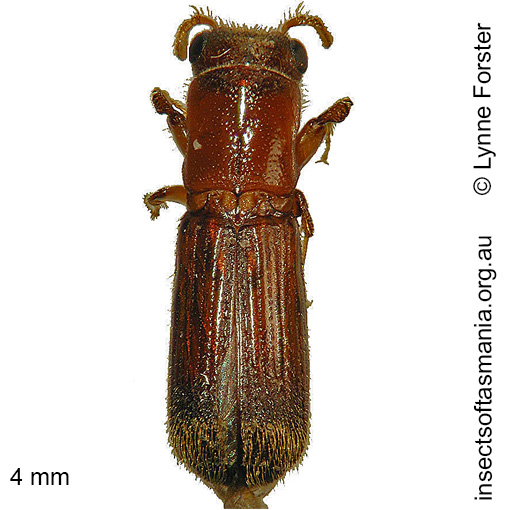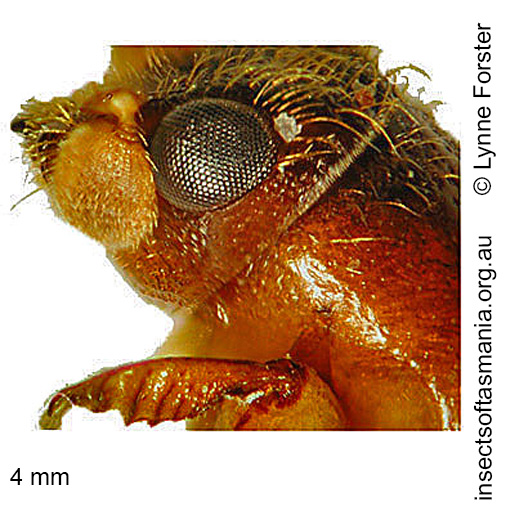
Platypus subgranosus (mountain pinhole-borer)
Basis for Tasmanian occurrence
Semmens, T.D., McQuillan, P.B. & Hayhurst, G. (1992). Catalogue of the Insects of Tasmania. Government of Tasmania: Department of Primary Industry, 104 pp.
TMAG collections
Classification
Order: Coleoptera
Suborder: Polyphaga
Superfamily: Curculionoidea
Family: Curculionidae
Subfamily: Platypodinae
Tribe: Platypodini
Morphology
Typical length (mm): 4
Flightedness: winged and assumed capable of flight
Ecology
Assumed larval feeding: fungus-feeder
Association with dead wood or old trees: obligately saproxylic
Ecological attributes: — Adults attracted to ethanol (Elliott et al., 1983) — Affiliated with burnt tree-wounds (Harrison, 2007) — Affiliated with larger-diameter logs (Yee et al., 2006) — Affiliated with older trees (Harrison, 2007) — Can inflict significant damage in timber of Eucalyptus and other spp. (Elliott & deLittle, 1985) — Can inflict significant damage on Nothofagus cunninghamii (Elliott & deLittle, 1985) — Can inflict significant damage on Pinus radiata (Elliott & deLittle, 1985) — Closely associated with Chalara australis infections on Nothofagus cunninghamii (Elliott et al., 1987) — May occupy logs or trunks of Eucalyptus obliqua, at least temporarily, since found having emerged within a year of felling (Grove & Bashford, 2003) — May occupy logs or trunks of Eucalyptus obliqua, at least temporarily, since found having emerged within six years of felling (Grove et al., 2009).
Collection method(s) for TMAG material: — Baited trapping (funnel trap) — Emergence trapping from cut billets of Eucalyptus obliqua (Harrison, 2007) — Emergence trapping from log of Eucalyptus obliqua — Flight intercept trapping — Hand collection (substrate not specified) — Hand collection from under bark (tree species not specified) — Knockdown fogging of canopy of Eucalyptus obliqua — Knockdown fogging of canopy of Nothofagus cunninghamii — Log-mounted flight intercept trapping — Malaise trapping — Panel trapping — Pipe trapping — Pitfall trapping — Rearing in insectary from Eucalyptus globulus — Sticky trapping (substrate not specified) — Sticky trapping on Acacia melanoxylon — Sticky trapping on Eucalyptus camaldulensis — Sticky trapping on Eucalyptus globulus — Sticky trapping on Eucalyptus obliqua — Sticky trapping on Eucalyptus viminalis — Trapping using a range of devices placed in crown of Eucalyptus obliqua (Bar-Ness, 2005) — Vane trapping.
Source ecological literature:
Grove, S.J. & Bashford, R. (2003). Beetle assemblages from the Warra log decay project: insights from the first year of sampling. Tasforests 14: 117-129.
Grove, S.J. (2009b). Beetles and fuelwood harvesting: a retrospective study from Tasmania’s southern forests. Tasforests 18: 77-99.
Hopkins, A.J.M. et al. (2005). Wood decay fungi and beetle assemblages associated with living Eucalyptus obliqua trees: early results from studies at the Warra LTER Site, Ta
Baker, S.C. (2006b). Ecology and conservation of ground-dwelling beetles in managed wet eucalypt forest: edge and riparian effects. PhD thesis, Univ. of Tasmania, Hobart.
Bar-Ness, Y. (2005). Crown structure and the canopy arthropod biodiversity of 100 year old and old-growth Tasmanian Eucalyptus obliqua. Msc thesis, Univ. of Tasmania, Hobart.
Elliott, H.J. & deLittle, D.W. (1985). Insect pests of trees and timber in Tasmania. Hobart: Tas. Forestry Commission, 90 pages.
Elliott, H.J. et al. (1983). The association of ethanol in the attack behaviour of the mountain pinhole borer Platypus subgranosus … J. Aust. Entom. Soc. 22: 299-302
Elliott, H.J. et al. (1987). The incidence and spatial pattern of Nothofagus cunninghamii … attacked by Platypus subgranosus …in Tasmania’s cool temperate rainforest. Aust. J. Ecol. 12: 125-138.
Grove, S. et al. (2009). A long-term experimental study of saproxylic beetle … succession in Tasmanian Eucalyptus … logs… In: Fattorini, S. (Ed.), Insect Ecology and Conservation. Research Signpost, pp. 71-114.
Harrison, K.S. (2007). Saproxylic beetles associated with habitat features in Eucalyptus obliqua trees in the southern forests of Tasmania. PhD thesis, Dept. of Zoology, Univ. of Tasmania, Hobart.
Yee, M. (2005). The ecology and habitat requirements of saproxylic beetles native to Tasmanian wet eucalypt forests: potential impacts of commercial forestry practices. PhD thesis, Univ. of Tasmania, Hobart.
Yee, M. et al. (2006). Brown rot in inner heartwood: why large logs support characteristic … beetle assemblages … In Grove, S.J. & Hanula, J.L. (eds.) Insect biodiv. and dead wood, pages 42-56. USDA For. Serv., SRS.


